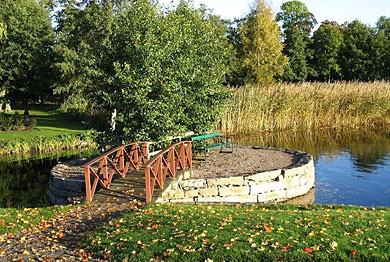Gripsholm Palace Park
A wander through the leafy castle park is like taking a walk through history. There have been many gardens over the ages here, and apples are grown in the orchard for The King's own apple juice, which is on sale at the castle. A visit to the tiny Lovers' Island is also highly recommended.
The east section of the island on which Gripsholm Castle is built has seen a number of small gardens throughout the years.
The first gardens were intended both for pleasure and utility and contained land for cultivation, where herbs, flowers and fruit trees were grown.
The park's history dates back to the 1500s and has seen interesting developments during each century since then.
A herb garden
During the 1500s a herb garden was cultivated at the west side of the castle.
The garden was enclosed by a fence with a door and also contained a small herb-garden cottage. In 1581 a garden pavilion was built in the form of a tower.
17th Century
At the time of the reign of Karl IX (1604–1611) the art of gardening developed considerably. Most probably the garden at Gripsholm was also developed and took on a more planned form.
Karl IX mentions in a letter the pleasure derived from wandering in the gardens at Gripsholm.
Queen Dowager Hedvig Eleonora (1636–1715) was said to have planted a vaulted vine-covered passage in the garden.
A new rococo style garden
The castle island was enclosed by a red picket fence with two gates.
In 1730, Carl Hårleman drew up a proposal for a new garden in rococo style. A brick wall with a tin plated top was built around the new garden.
The work took a number of years to complete, but it remains uncertain as to how much of Hårleman's design was followed.
The trees that grew on the island contributed to a languishing feeling and were therefore chopped down.
The ground was considered too marshy and for that reason was re-filled and cultivated with new low stem-med trees. And the strand was fortified with a stone wall.
King Gustav III
Gustav III (1771–1792) ordered the removal of the wall around the Hårleman garden at the end of the century and transformed the area into a park.
One or two lime trees that are found on the west side of the castle may originate from this time and form most probably the remains of a tree-lined avenue.
19th Century
During the 1800s the gardens at Gripsholm were developed considerably. The system of paths was extended and developed according to the romantic spirit of the times.
A large number of trees were planted to line the roads and were also intermittently dispersed over the grass lawns. Extensive arrays of flowers were planted by the roadsides and a number of seating areas were also built.
In 1897 the "great" orchard was planted on former pasture land in the area know as Hjorthagen (deer pasture). Some 3,600 trees were planted. At the time it was the largest fruit cultivation in Sweden.
Tons of apples
During the Second World War between 80–100 tons of apples were harvested each year.
The last big apple year was 1970–71. After that the operation was no longer considered commercially viable and was phased out.
At the end of the 19th century a greenhouse was built adjacent to the castle. The greenhouse seen today is a reconstruction of the one that existed at the end of the 1800s.
20th Century
During the 1900s the gardens consisted mostly of remains from the extensive parks cultivated in the 1800s.
One or two trees, for instance the lime trees on the island's west side, may originate from Gustav III's time. During the 1900s, the gardens have successively been thinned out and cleared.
The park creates a shady frame around the castle, providing pleasant walks.
A continuing tradtiton
Today, the Gripsholm Castle administration continues to work according to tradition, growing the flowers needed to decorate the castle in the modernized greenhouses.
Flowerbeds and flower monograms can be seen around the castle. On the west side a small herb garden grows on the west side. It was planted in 1993 in commemoration of the Carthusian monastery Pax Mariae.
An orchard containing approximately 250 fruit trees produces the apples needed for the castle's production of apple juice that is sold on site.
Photo: Raphael Stecksén/Royalpalaces.se

Horticultural techniques were developed during the time of King Karl IX (1604-1611), and the gardens at Gripsholm were probably given a more organised form. Photo: Raphael Stecksén

The network of pathways was expanded and set out in the Romantic style during the 19th century. Photo: Raphael Stecksén/Royalpalaces.se

The history of the park begins back in the 16th century. Johan Niclas Byström's statue of Hebe stands in the castle park. Photo: Raphael Stecksén/Royalpalaces.se

The flowers used to decorate the castle are grown in a modernised greenhouse. Photo: Raphael Stecksén/Royalpalaces.se

"Lovers' Island", a small islet at the castle on the water's edge. Photo: Royalpalaces.se









